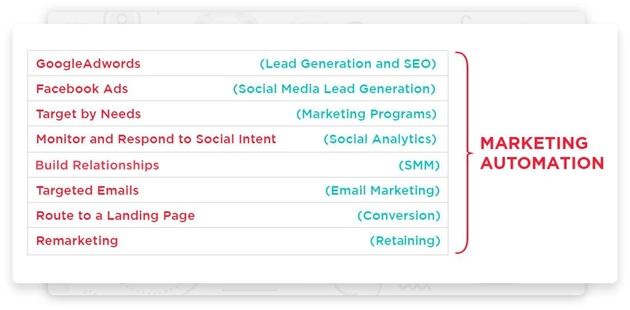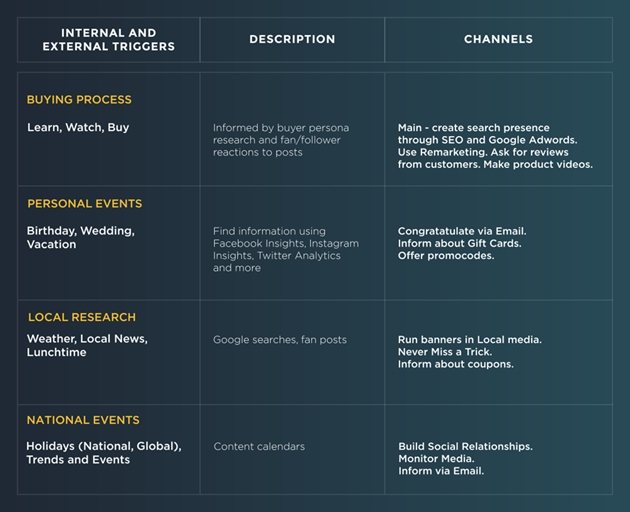In his seminal blog post about social media marketing, Neil Patel writes that "social media marketing is the process of creating content that is tailored to the context of each individual social media platform, in order to drive user engagement and sharing." He goes on to say that while it's important to create content that works, it also has to make users want to share it.
What better way to do that than by delivering the content people want to see, via the channel they want to use, at the time they want to see it?
Understanding the basics of contextual marketing will help you accomplish that feat.
What is contextual marketing?
Contextual marketing involves getting the right message to the right person at the right time. It uses content that starts a conversation and engages customers to create a meaningful and lasting experience.
That content has to be visually pleasing and written well, of course, but it's vitally important to know what to deliver in the first place—and also when.
Find the Right Person and Where They Are (the "Who" and "Where" Parts of the Equation)
First, you have to know your customer to be able to connect on their level. Complete your buyer persona or audience persona research, and do the due diligence associated with timing your campaigns.
Today's consumers are totally connected. They respond to personalized content that adds value to what Google calls "micro-moments"—those times a person is using a mobile device for research or shopping. To understand how to capture those micro-moments, you need to understand what your customer wants during them:
- Usage research: How does your target audience use digital media? When are they online? What platforms do they visit most? When do they visit them?
- Why is your audience using a platform at a particular time? Anticipate pain points so you can craft the right message when the time comes.
- Brand research: How does your audience feel about your brand? What do they expect in terms of marketing content from you, based on what you've already been giving them?
- Surveys: What better way to understand the customer's mind than to ask them? Surveys can give a brand critical information about what people expect.
Find the Right Message and the Right Time (the "What" and "When" Parts of the Equation)
Part of your context market research should include figuring out what sort of message you should be sending to your audience. Regular content marketing focused on campaigns, media schedules, CPMs, and relevant-as-possible messaging.
Contextual marketing focuses on engagement, interactions, customer recognition, moments of engagement, and contextual utility, including...
- Shifting from product to consumer-centric messaging. It's important to find something that resonates with your audience at the time you're communicating with them.
- Finding the right time to communicate with your audience. If you see that your audience is active on a social channel at lunchtime, offer them a coupon for a restaurant near them. The most powerful thing you can give your audience is something they want right at the moment they want it.
- Using creativity and stunning visuals and engaging and delighting your audience. (Here is an article devoted to the creation of stunning visuals.) Visual is the best way to communicate in social media marketing. Studies show that visual Facebook posts get 53% more likes than plain text posts, and image-based Instagram has surpassed Twitter in daily users.
Contextual Touchpoints
Consider some contextual touch points to help you figure out the type of content you should post:
In addition, the way you present your message has to have some context in marketing your service and product. In other words, the blog post, social post, or ad you place in front of your audience has to lead them somewhere they want to go. It has to create an experience, build value, or encourage engagement. Whether you're looking to convert your social audience into leads or leads into customers, you need to have a strategy in place. You can do so via...
- Smart CTAs: Customize the call to action based on a user's industry, location, past activity, or their position in the sales funnel.
- Personalized social marketing with one-on-one interactions via Facebook conversations, Tweets, and other social media conversational tools.
- Making the connections between different digital touchpoints and customizing your messaging accordingly.
Contextual marketing is an important component of content marketing because it is all about personalizing the user experience, rather than merelybeing about using a digital platform to evangelize your product or service.
Once you have your message and its goal in place, it's time to figure out a management and delivery system.
Find the Right Technology (the Ever-Important "How" Part of the Equation)

Think your marketing automation over, but never ignore the CDP (Client Data Platform). A great variety of tools, both online and offline, are designed to manage existing customer relationships and identify new prospective customers. You have to find the right tools that help you to...
- Connect all platforms to your content. It's crucial that you connect on as many touchpoints as possible, and that you integrate the data into your context analysis, marketing successfully to your users in a way that seems seamless.
- Make sure that your content is heavily personalized. Know your customer's name, her purchase history, the posts she's liked in the past, and what she's had to say about your brand. It takes a powerful data repository to collect that type of information.
- Automate your content. It's going to take you time to collect all the rich data that will make marketing in context possible.
You might choose to combine several technologies to find the right mix.
* * *
In a nutshell: delivering the right content to the right person at the right time may sound easy, but a lot of work goes into figuring out each part of the equation. Luckily, there are tools and resources that will help you deliver content that engages, surprises, and delights your audience.





